Content warning
This story may contain sensitive material or discuss topics that some readers may find distressing. Reader discretion is advised. The views and opinions expressed in this story are those of the author and do not necessarily reflect the official policy or position of Vocal.
The worlds remaining cannibals
Most dreaded tribes
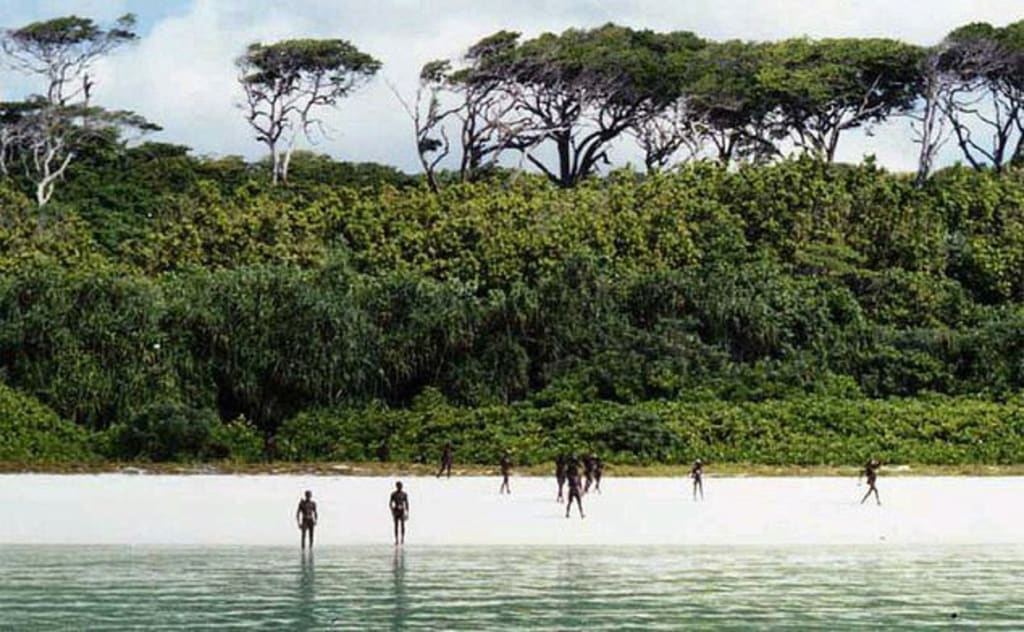
Feasting on unburied corpses, using skulls as cooking utensils and eating human flesh as part of dark magic rituals: these are just a few of the stomach-turning practices still observed by the world's remaining cannibal tribes.
It is perhaps for this reason that scientists and explorers alike have long been fascinated with the remote tribes of the world, none more so than cannibal tribes. Many have risked life and limb to get close to such groups, in some cases with tragic consequences. But it is thanks to their efforts that we know the little that we do. Here, lets explores what we know about some of the world's cannibal tribes.

A member of the Indian Aghori tribe is seen pouring water from a human skull
Cannibal tribes, such as the Asmat inhabit corners of the world that have remained mostly untouched by modern civilization, and thus have been sheltered from outside influences. As a result, their ways and traditions can date back thousands of years and are so far detached from our own, they seem almost alien.
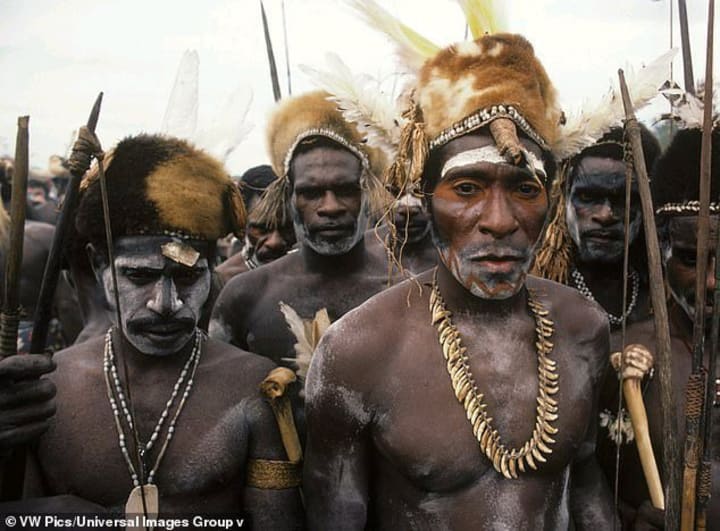
Members of the Korowai tribe are seen gathering in West Papua, Indonesia.
It has long been thought that the tribe are cannibalistic, although this has been questioned. The Sentinelese are considered one of the Earth's last uncontacted tribes and are extremely hostile to outsiders. It was long rumoured that they were cannibals, but this has been brought into question by surveys carried out by the Indian government.
THE AGHORI
They are based in the northern Indian city of Varanasi, are known as the most feared 'cannibal cult' in India and Nepal. They have chosen Varanasi as their home on account of its location on the banks of the Ganges River, but they are not rooted to it.
With around 2,000 temples lining its streets, the city is a holy place. Hindu Pilgrims travel from far and wide to bathe in the river's sacred waters, perform funeral rites, and in some cases travel there to die. The Aghori, meanwhile, practice a small and extreme sect of Hinduism, notorious for its practice of eating human flesh and using human remains in its rituals.
Dating back to the fifth century, the tribe moves between India and Nepal, with its people living among the cremation grounds along the banks of the holy river, where bodies are routinely burned and scattered into its sacred waters. Such funeral rites are often carried out here on account of the families of the dead being unable to afford more expensive ceremonies. Members of the Aghori use some of these remains cast out into the Ganges for their own practices, which have been captured in striking photographs over the years. One chilling image, captured in a 2018 series, shows a man as he tipped his head back and raised his hands before drinking from the mouth of a real human skull.
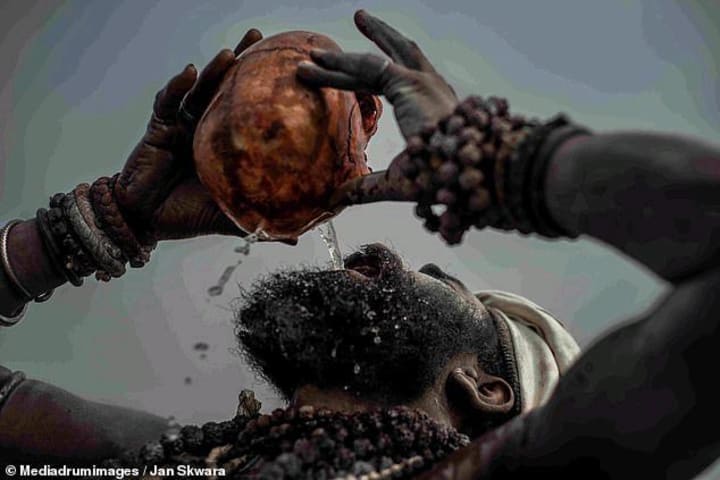
Based in the northern Indian city of Varanasi, the Aghori are known as the most feared 'cannibal cult' in India and Nepal.
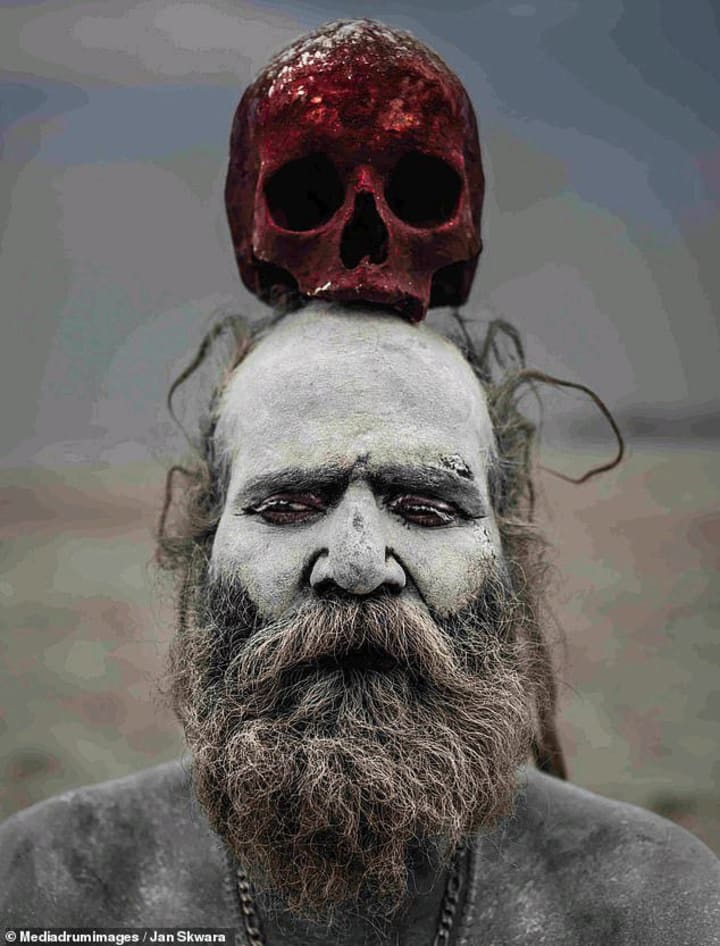
An Aghori tribesman is pictured in 2018 with a red stained skull sitting on his head. His skin is covered in a grey-white dust.

In another picture, a man is seen sitting down with a red human skull perched on top of his own head, his face covered in an eerie white dust.
The tribe's monks use herbal drinks, alcohol and meditation in their rituals, we all as human flesh. The white dust is believed to be human ashes. Polish photographer, Jan Skwara, 38, was travelling through Varanasi when he captured the pictures. He gave details on the tribe at the time. Whilst they worship the Hindu deity of destruction, Shiva, Aghori practices are seen as being contradictory to orthodox Hinduism. Shiva, it is believed, resides in cremation grounds, explaining why the Aghori live among them.
Jan said the Aghori believe in asceticism, a lifestyle in which one denies themselves of sensual pleasures choosing instead to pursue spiritual goals. It is said that the Aghori exist in the space between life and death. They usually live close to crematory grounds and collect 'human oil' from corpses, Jan said in 2018. Post-mortem practices are considered to be filthy in Hinduism but the Aghori disagree with this.
They have their own belief system built upon providing offerings to their God and consuming polluted things like human flesh, excrement, or toxins. There are many Aghori who choose not to partake in these ancient traditions. Instead, they engage in positive social change, even a former president of India was Aghori. However, others live outside of society pushing asceticism to the extreme.
The Aghori don't like visitors, especially tourists, as their lives are concentrated on praying and meditation. However, Jan said he was able to visit them after he met a young man who was a former member of the tribe. Aghori people only eat the flesh of deceased corpses and often also use bodies as altars to forge a connection to the sect's deities.
Asceticism promotes ridding yourself of passion, lust, and shame. For this reason, Aghori people wear very little clothing as a way to rid themselves of any shame. They are also not interested in receiving any fame or notoriety. It was difficult to find anyone who could take me to see them. I must confess, it is scary to see all of the skulls,' Jan said.' They behave strangely sometimes screaming or running around.
Aghori rituals may seem shocking to Western people but they are largely accepted. It's hard to describe the Aghori as their philosophy is so complex. There are no rules to how they should behave. Many follow their own individual paths. A spotlight was shone on the group in 2015 when CNN broadcaster Reza Aslan courted controversy by visiting the group and taking part in a ritual. He met a number of the monks from the tribe and was filmed eating human brain while taking part in a ritual. He left the network soon after. The Aghori themselves have faced criticism and skepticism in India.
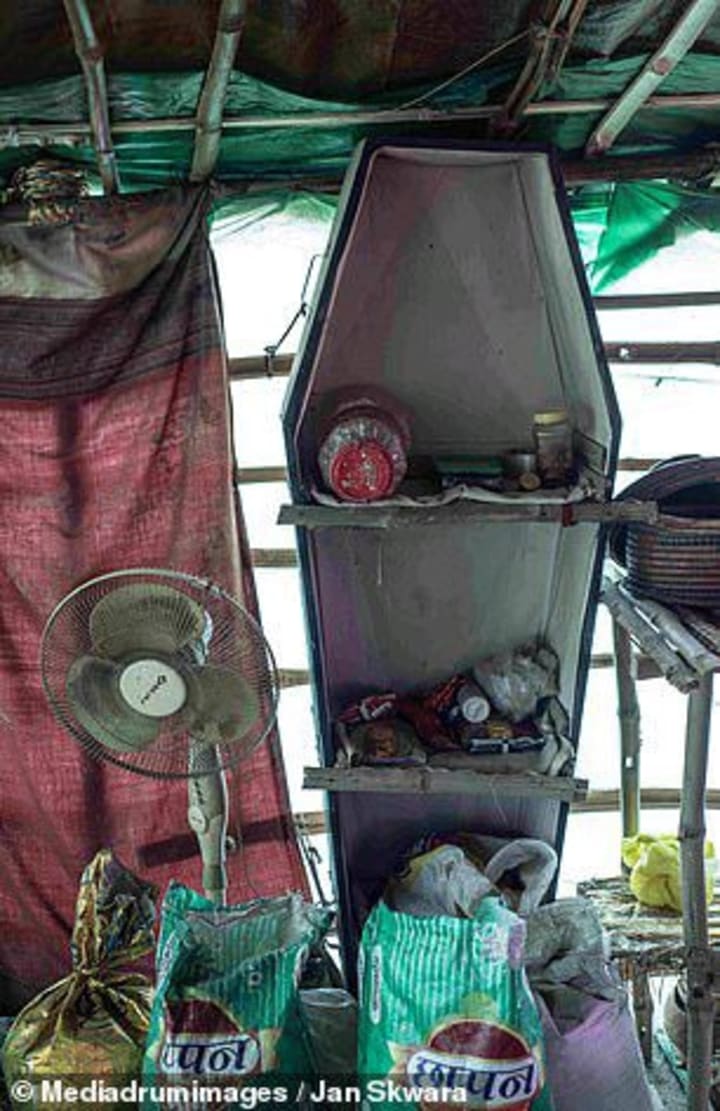
One worshipper's home used an empty coffin as a shelving unit.
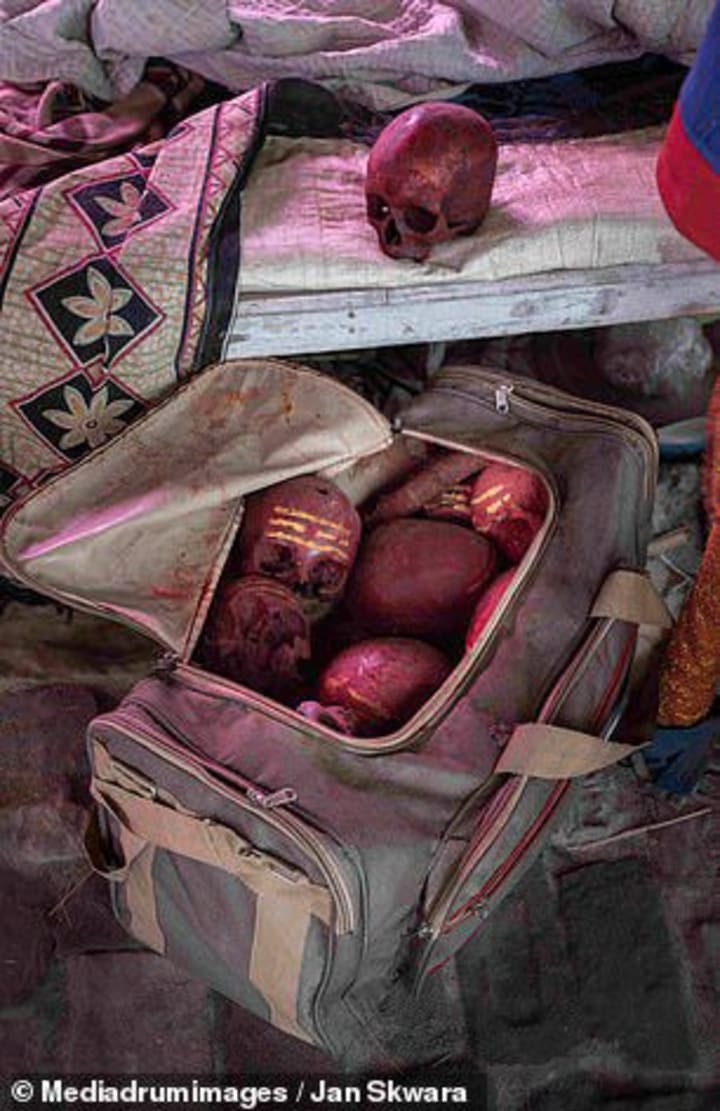
A gym bag of collected human skulls are seen at the foot of his bed.
Another photographer who spent time with the tribe in 2016, said this was largely because they were misunderstood. The Aghor see beauty and light in everything, and they don't feel fear, hate or disgust. They follow a path of non-discrimination,' she said.' With the consumption of human flesh, they affirm that nothing is profane or separate from God, because for them a corpse lacks the soul it once had. Despite their extreme practices and lifestyle, a true Aghor will keep himself away from killing, and will never hurt or damage anybody.
THE ASMAT
The Asmat tribe are an ethnic group living in New Guinea, occupying 10,000 square miles of jungle swap in Indonesia's province of South Papua. They were first encountered by Europeans when the Dutch came across them in 1623, however they remained almost entirely isolated from other ethnic groups until the 1950s, when they came into more regular contact with outsiders.
Until then, it was well known that the tribe often complete with face paint, headdresses and spears were feared headhunters and cannibals. As a result, they were left well enough alone for many years. The Asmat tribe are an ethnic group living in New Guinea, occupying 10,000 square miles of jungle swap in Indonesia's province of South Papua

A member of the Asmat tribe is seen in face paint and a headdress, in this 1976 photograph.
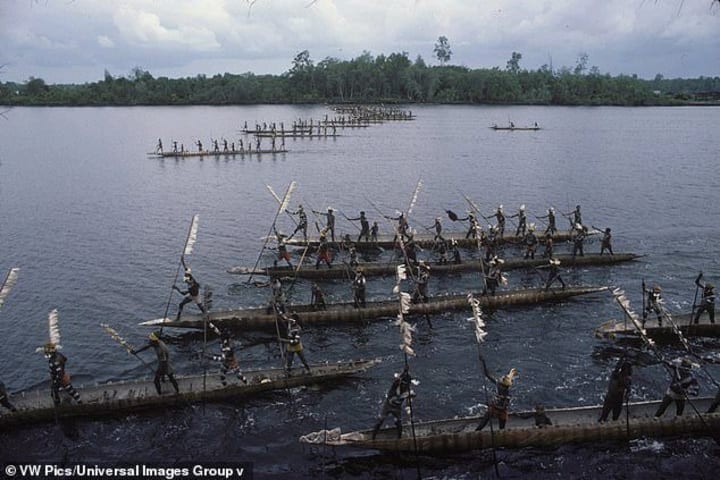
Asmat people are seen standing on rafts in this photograph taken in 1976.
While the Asmat tribes were ferocious headhunters, they have also made stunning wooden sculptures (rubbed with the blood of those they killed) as well as hauntingly beautiful decorated skulls. These they collected from tribal foes, having eaten their brains in a sacred ritual they believed would give them the dead men's power.
Their bloodthirsty way of life revolved around endless revenge attacks against neighbouring villages. Each time a tribe member was killed, he had to be avenged by taking the skull of an enemy whether man, woman or child. The skulls of their victims are believed to be used in cooking. A journalist wrote of the group: They shook the brains out onto the leaf of a palm, scraped inside the skull with a knife to get every last bite, then mixed the mass with sago, wrapped the leaf up, and roasted it on the fire. This food was special, he added.
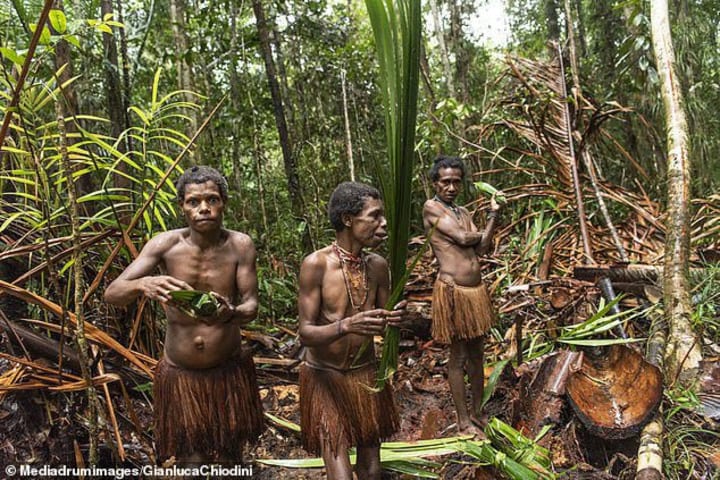
His writing on the tribe was in relation to an unusual mystery involving Michael C. Rockefeller, the 23-year old son of New York governor Nelson Rockefeller and future Vice President, who is believed to have gone missing. His disappearance sparked the biggest hunt ever launched in the South Pacific at the time. But since Rockefeller disappeared during a trip to collect primitive art from one of the remotest corners of the planet, rumours swirled about his fate.
The official explanation advanced by the former colony's Dutch rulers was that he drowned after he tried to swim to shore from his capsized boat. Others insisted he met a more horrible fate, killed and eaten by cannibals seeking revenge on white men for a Dutch attack on their village.
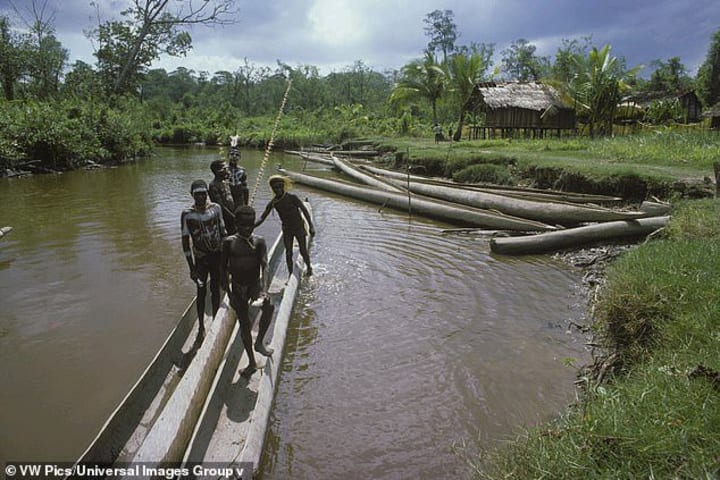
Asmat people in the Papua province of Indonesia, along the Arafura Sea.
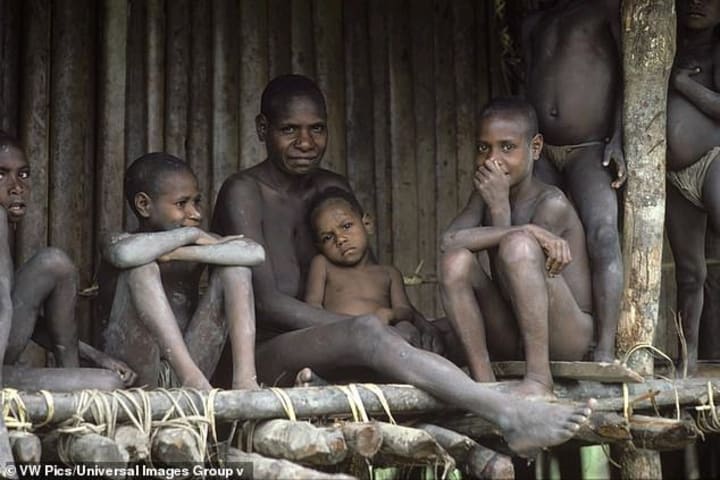
A mother and her children children are pictured in the Village of Pirien in this photograph taken by Francois Gohier in 1976.
It is this theory that was put forward by Hoffman in his 2014 book 'Savage Harvest' in which he claims that Rockefeller was brutally killed and eaten by the tribe. The Asmat remain relatively isolated today, and their traditions are strong. That being said, their interactions with the outside world have been increasing in recent decades. Some have received higher education in Indonesia and Europe, and they have found ways to incorporate new technology into their way of life. Despite their reputation for bloodshed, their artwork, particularly their woodcarvings is sought by collectors worldwide.
THE KOROWAI
Like the Asmat, the Korowai also hail from Indonesia's Papua - from southeastern Papua in the Indonesian provinces of South Papua and Highland Papua. They number around 4,000 to 4,400 people and according to the Daily Telegraph, were unaware of the existence of people other than themselves until the late 1970s. The majority of the Korowai tribe members live in treehouses in their isolated forest territory, but some have moved into villages since the 1980s. Ever since they were discovered, the tribe have been rumoured to be cannibals who live in treetop houses.

A Korowai tribesman uses a bow with a long arrow in this photo taken in 2006
The Korowai number around 4,000 to 4,400 people and - according to the Daily Telegraph - were unaware of the existence of people other than themselves until the late 1970sMembers of the tribe today still encourage such stories when asked by Western visitors, but while they certainly once lived among the branches, there is limited evidence to support claims they ate human flesh.
Their first documented contact with the outside world was when a group of scientists met with members of one clan in 1974. An Australian reporter later claimed the tribe practised cannibalism but this has been disputed by some. And while the Korowai previously lived in communal tree houses high up in the jungle canopy, the clans have increasingly moved into settled villages.
Last year, the tribe was the subject of a BBC blunder when a film team following up on the 2011 series Human Planet discovered that the tree houses had been built for the benefit of the show and were not lived in by the tribe. In BBC Two's My Year With The Tribe last year, Adventurer Will Millard visited the Korowai where during a trip to a treehouse they told him the raised houses are not our home and that they were commissioned for filming.
What I found when we got to Korowai territory was that, actually, in the more contacted, accessible places, there was something of a Korowai tourist economy going on, where they were putting on a performance for the benefit of rich tourists, Mr. Millard said at the time.
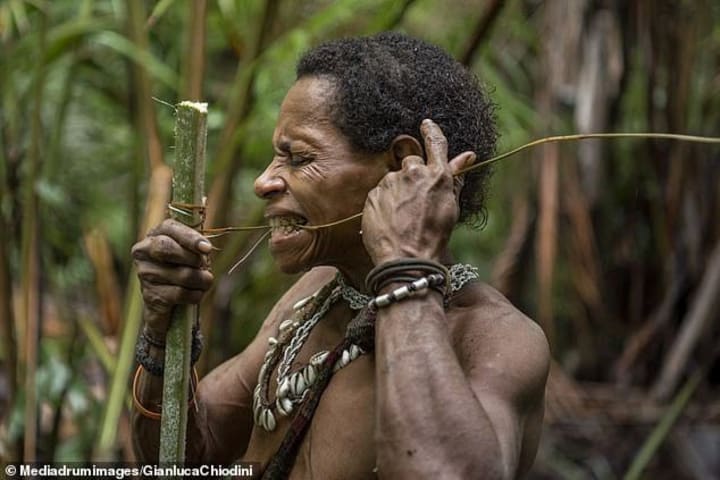
A Korowai tribesman uses his teeth to secure a knot on his improvised tool.
The Korowai do not have access to many modern medicines. The BBC later released a statement saying it 'breached editorial standards' by inaccurately portraying the life of the Korowai. The Korowai do not have access to many modern medicines and diseases are treated with herbs, so the mortality rate is typically very high. Not having the relevant scientific knowledge, the tribe reportedly believed that deaths are caused by 'khakhua' or demons that take the human form. Some say that anyone killed by a demon was eaten by the remaining tribe members, a curious revenge ritual to protect the rest of the Korowai people, although this has been disputed.
Certain anthropologists believe that clans in the tribe have perpetuated the myth of cannibalism to promote interest and tourism. However, Australian journalist Paul Raffaele, who was the first Western man to infiltrate the Letin clan, an offshoot of the Korowai tribe, reported that he did witness some of its members eating human flesh. In an interview with Vice in 2014, he said: 'For the Korowai, if someone falls out of a tree house or is killed in battle then the reason for their death is pretty obvious.
But they don't understand microbes and germs (which the rain forests are rife with) so when somebody dies mysteriously to them (of a disease), they believe it is due to a khakhua, a witch man who comes from the netherworld. A khakhua possesses the body of a man (it can never be a woman) and begins to magically eat their insides, according to logic of the Melanesian imperative you must pay back in kind. They must eat the khakhua as it ate the person who died. It is part of their revenge based justice system.
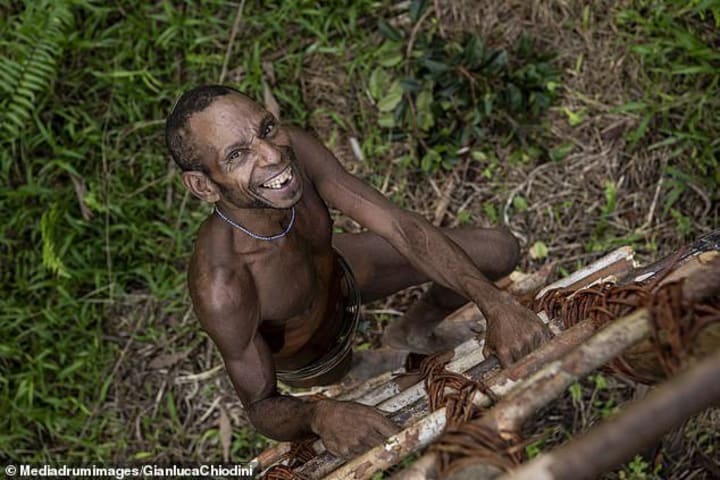
A Korowai tribesman is seen climbing a ladder while being.
He described how he met a man named Kili-Kili, who was the 'most notorious khakhua killer'. The man showed Raffaele the skull of a man who was killed. The journalist said the tribe steam everything with an oven made from leaves and rocks. They treat it like they would the flesh of a pig. They cut off the legs separately and wrap them in banana leaves. They cut off the head and that goes to the person who found the khakhua. That's why Kili-Kili had the skull, he said.
THE SENTINELESE
With their poison arrows, knives, spears, clubs, axes and rocks, the Sentinelese are a people that perhaps best fits the image most have of a remote, isolated tribe. Infact, the Sentinelese tribe, hailing from the tiny island of North Sentinel in the Bay of Bengal has become known as the world's last Stone Age tribe, and remain one of the world's few remaining 'uncontacted peoples'. This means that we know tantalisingly little about their language, culture, belief system or even how many of them that are alive today. What we do know is that they have lived happily and largely healthily on their tiny, lush, 20-square-mile island for at least 30,000 years and possibly even longer.

A Sentinelese man aims with his bow and arrow at an Indian Coast Guard helicopter as it flies over the island for a survey of the damage caused by the tsunami in 2004.
The Sentinelese tribe has attacked almost everyone who has entered their territory.
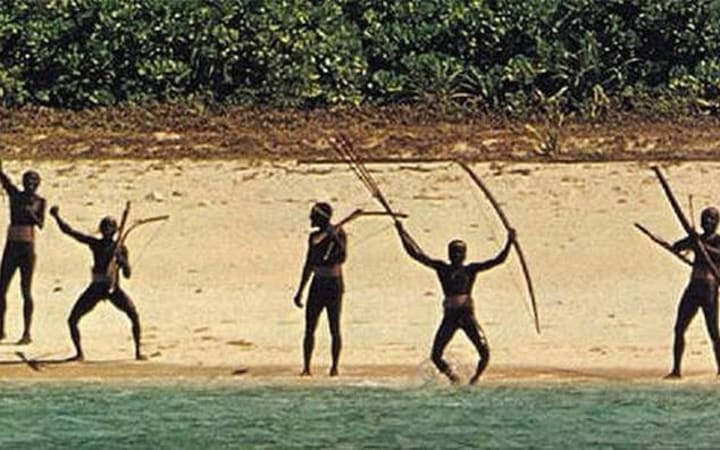
The tribes people are seen wielding arrows on the island
John Allen Chau, 26, was shot dead with arrows by tribesman when he arrived at North Sentinel Island, one of the world's most isolated regions in India's Andaman islands.
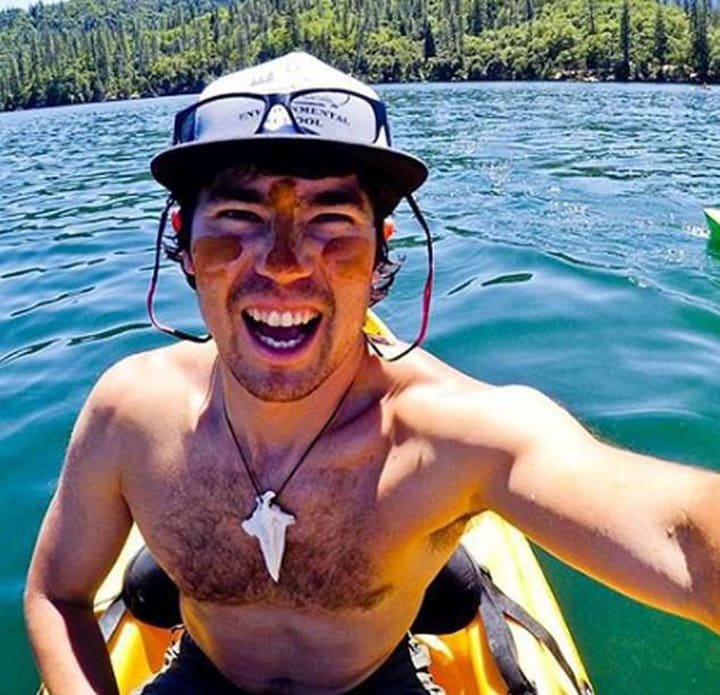
During that time they have mostly lived off wild pigs, clams, berries and honey and engaged in energetic communal sex sessions on the beach. At the same time, they have repelled pretty much every visitor (well-meaning or threatening) with a flurry of poison arrows and razor sharp machetes. It came as little surprise then that John Allen Chau, a 26-year-old American Christian missionary-cum-thrill-seeking explorer, met his end on the island in 2018. He visited the island that year and was felled by a poison arrow, before being dragged round the white sand beaches by a piece of twine until he was dead.
Apparently Chau, a graduate of the evangelical Oral Roberts University, Oklahoma, who had previously declared visiting North Sentinel as his 'must-do adventure', had decided his life's calling was converting the Sentinelese to Christianity. But his fate made it clear why the Indian government has made it illegal for anyone to go within five nautical miles of the islands. Even filming the natives in the Andaman Islands which include North Sentinel, was made illegal in 2017. This is partly to protect visitors such as Chau, from the natives deadly tendencies. But it is also to ensure the continued survival of the world's last pre-neolithic tribe who are a people that are so isolated they are unlikely to have any resistance to common illnesses such as flu, measles or even a cold.
The Sentinelese attracted international attention in the wake of the 2004 Asian tsunami, when a member of the tribe was photographed on a beach, firing arrows at a helicopter (pictured). It was for a long time thought that the Sentinelese were cannibals. However, this has also been disputed. A 2006 analysis of the tribe by the Indian Government following the death of two fishermen on the island found that they did not eat the two men. The Sentinelese not eating the deceased is a contradiction to the common belief that these tribes are cannibals, the report said. It is believed that the misconception grew from a misunderstanding about a neighbouring tribe, the Onge, who cut up their dead and burned their flesh to prevent them from being consumed by evil spirits.
About the Creator
Enjoyed the story? Support the Creator.
Subscribe for free to receive all their stories in your feed. You could also pledge your support or give them a one-off tip, letting them know you appreciate their work.





Comments
There are no comments for this story
Be the first to respond and start the conversation.